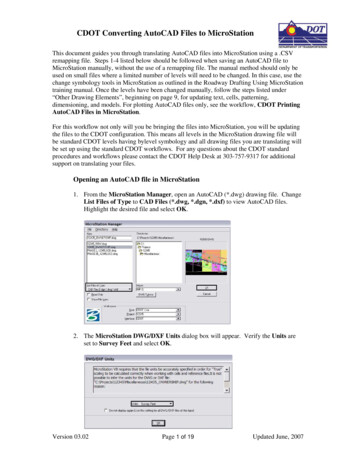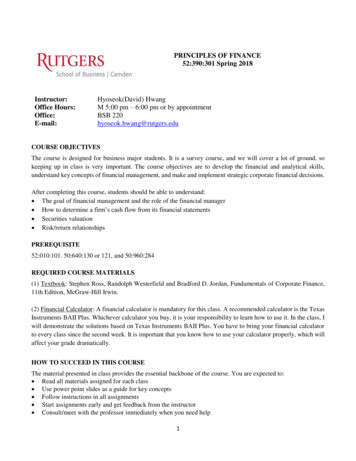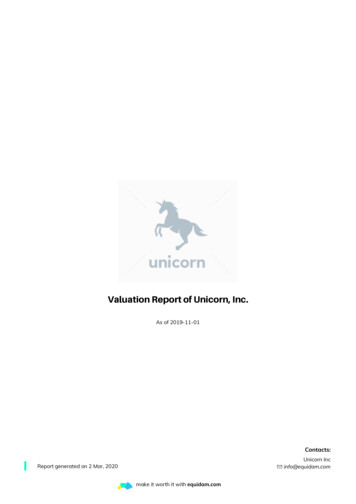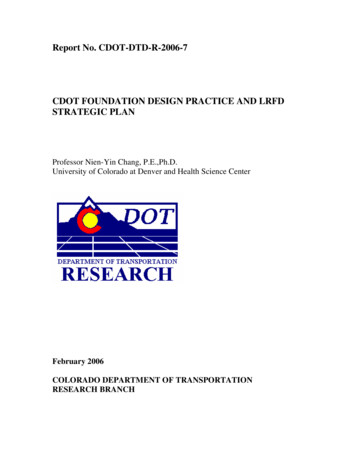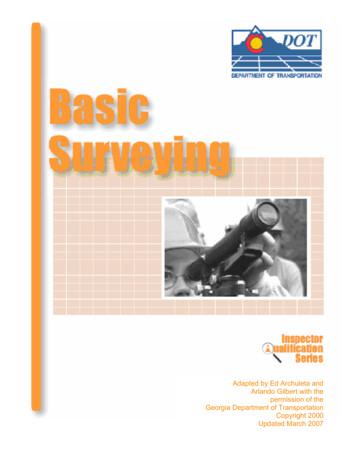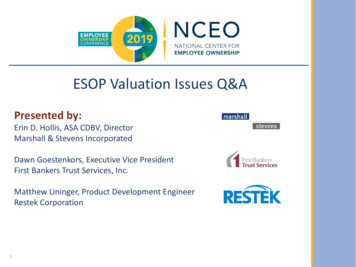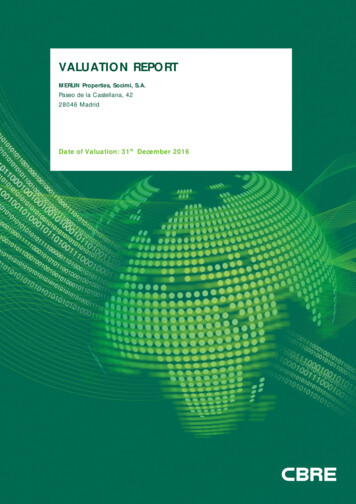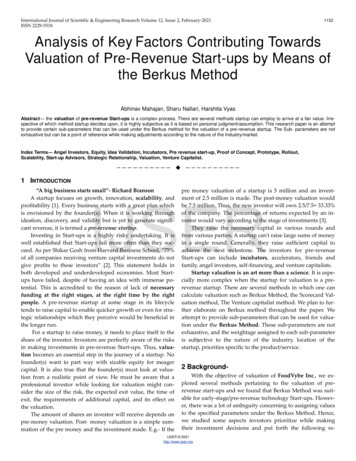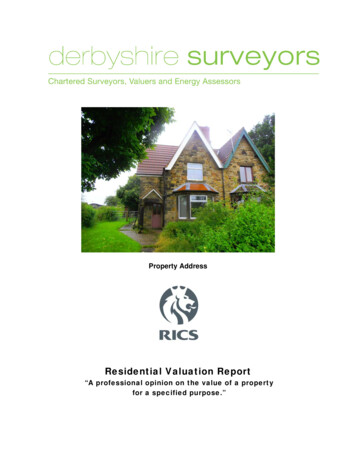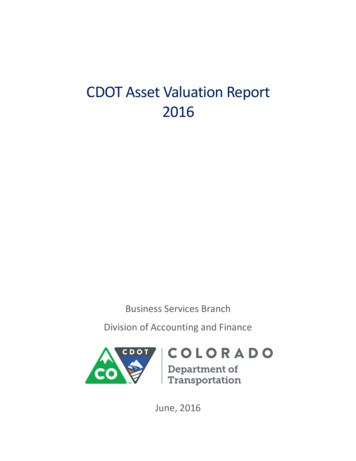
Transcription
CDOT Asset Valuation Report2016Business Services BranchDivision of Accounting and FinanceJune, 2016
Asset Valuation Report 2016Colorado Department of TransportationExecutive Summary Asset valuation is the process of estimating the current monetary value of anagency’s assets. Proper valuation supports robust investment decisions and trade-off analyses,improves asset management, leads to better evaluation of risk and resilience,informs economic analysis of highway system/investment, shows good stewardshipof public assets, and justifies additional investment in assets. Based on the available data, a combination of different asset valuation approaches ischosen for the infrastructural assets of CDOT. The assets of CDOT are estimated to be 31.7 billion in current value and 44.5billion in replacement value. This report paints a general picture of the asset value and serves as the first steptoward a sustained effort to understand and improve the infrastructural capital ofCDOT. CDOT is the first DOT in the United States to undertake an asset valuation projectof transportation infrastructure of such scope and depth.1
Asset Valuation Report 2016Colorado Department of Transportation2
Asset Valuation Report 2016Colorado Department of TransportationTable of ContentsExecutive Summary . 1Introduction . 5Importance of Asset Valuation . 7Asset management improvement. 7Risk mitigation and Resilience . 8Policy, transparency and accountability . 8Economic Vitality. 9Conceptual Framework.11Overview of Approaches .15Asset Valuation Examples .17Bureau of Reclamation .17Australia and New Zealand .17Utah DOT .18Recommended Approach for CDOT .19Results.21Bridge .25Building .27Culvert .29Fleet .32ITS.34Pavement.36Signal .38Tunnel .41Wall .44Next Steps .46References .47Appendix .48A.1 Monte Carlo simulation detail .48A.2. Methodologies and Assumptions . 49A.3. Glossary .573
Asset Valuation Report 2016Colorado Department of Transportation4
Asset Valuation Report 2016Colorado Department of TransportationIntroductionAsset valuation is “the process of assigning monetary value to an asset”, and it has beenrecommended as a vital part of transportation asset management by federal agencies,intergovernmental organizations, and trade groups. The OECD has recommended a data-drivenapproach to asset management that includes asset valuation, and the Federal HighwayAdministration has stated that “the value of an asset is a very important factor in the planningof strategies for its long-term preservation, maintenance, rehabilitation, and replacement.”Asset valuation is a long-term strategy. At the very least, asset valuation helps save cost byidentifying the current and future values of assets. For high-value assets such as pavements andbridges, it can be cheaper in the long run to keep the asset in fair condition than to replace afailed asset. On the other hand, it can be more cost-effective to replace low-value assets ratherthan to repair them. As such, a suitable asset valuation approach promotes an efficient balancebetween maintaining well-performing assets and repairing or replacing deteriorating assetswhile working within the constraint of a budget.Most Australian states and New Zealand, pioneers in transportation asset valuation since 1990,have found success since implementing their respective asset valuation strategies. Similarly,Utah DOT adopted an approach that incorporates asset valuation into a tiered system based onvalue and risk that forms the core of its asset management plan. Australia, New Zealand, andUtah are comparable to Colorado in terms of diverse geography, complex climate with extremeand variable weathers, and a mostly rural landscape dotted with large population centers.Colorado should pay close attention to the examples of these pioneers, who share many of thesame challenges in transportation asset management.However, as with many government goods and services, there are challenges to valuatingpublic infrastructure. Many competing or complementing methods of transportation assetvaluation are possible, stemming from engineering, accounting, and economic perspectives,and these methods can produce radically different results. When CDOT adopts a specificapproach, we must keep in mind the uniqueness of many of our assets and implement astrategy that unifies our data availability, information technology, and existing assetmanagement methods and skillsets.With this in mind, the analyst team developed a set of methodologies to valuate CDOT assetsthat make the most economic use of available data without imposing undue burdens on theasset management teams. From this, the analyst team produced results that are detailed toeach asset, repeatable, and well suited for vigorous analyses to understand CDOT’s5
Asset Valuation Report 2016Colorado Department of Transportationinfrastructural capital stock. To the best of our knowledge, CDOT is the first DOT in the UnitedStates to undertake an asset valuation project of transportation infrastructure of such scopeand depth.The remainder of the report is organized as follows. Importance of Asset Valuation andConceptual Framework introduce the motivations and basic ideas behind asset valuation.Overview of Approaches and Asset Valuation Examples sample some of the current theories andpractices in asset valuation in the critical infrastructure sector. Recommended Approach forCDOT and Results outline the methodologies adopted by the analyst team and some high levelanalysis of the results. Next Steps discusses potential use and expansion of the current body ofwork. Technical details are included in the Appendix.6
Asset Valuation Report 2016Colorado Department of TransportationImportance of Asset ValuationA transportation network is a public good with both intrinsic value from its physical capital andderived value from its use. As critical infrastructure, the value of a transportation network ishighly significant in terms of both government assets and economic impact, and a lack ofunderstanding of its value deprives relevant and crucial information from asset managers,policy makers, and the public at large.Asset valuation addresses this information gap. The incorporation of a suitable valuationapproach into CDOT’s asset management plan will not only yield the value of our assetinventory, but also increase our cost effectiveness, decrease long-term cost, and over all informbetter policies, hence further leading to freed resources that can be applied to enhance assetperformance, expand transportation network, and ultimately promote economic growth.Asset management improvementAt a bare minimum, asset valuation yields the current value of an agency’s capital stock, whichshould serve as the baseline metric that the agency needs to maintain. In industrialized nationssuch as the United States, the transportation infrastructure is considered mature andexperiences relatively little growth, therefore maintaining the current value of theinfrastructure must be a priority in any transportation asset management plan.However, asset valuation informs much more than the total value of a transportation network.It requires suitable assumptions about how different types of physical capital depreciate atindividual levels over time. These assumptions allow us not only to estimate the current valueof the assets, but also to have a realistic expectation of how much the asset will be worth in thefuture with or without reinvestment. Having such insight into the future is the key reason whyasset valuation creates long-term cost savings by providing information that facilitates betterallocation of resources both among assets and among time periods.Asset valuation cannot replace other approaches in asset management, as budget limitations,economic impact of construction, engineering feasibility, technological innovations andobsolescence, and unforeseeable circumstances cannot be fully predicted by the mathematicaland accounting models used in asset valuation under simplifying assumptions, but it willprovide a wealth of information that will significantly enhance asset management in acomprehensive approach.7
Asset Valuation Report 2016Colorado Department of TransportationRisk mitigation and ResilienceRisks stem from a variety of sources, including funding shortages, information unavailability,natural disasters, unforeseen asset failures, unusual or changing traffic patterns, and theassociated public safety issues. These risks complicate transportation asset management, butthey can be mitigated by properly identifying the likelihood and potential impact of a risk eventbased on the asset’s location and use. For example, asset failure due to a natural disaster ismore likely in the mountainous regions than on the plains, and a failure that occurs in an urbanarea or along a major corridor will likely cause a much larger impact than a failure that occurs ina remote, rural region.Asset valuation is an important addition to risk management, and a well-formulated assetvaluation strategy must account for these risks inherent in transportation assets. Whendisasters strike, we would have an instant assessment of the financial impact, and when risksare factored in the value of an asset, it provides further insulation against the damages; whenthe probability of a failure event is high, asset valuation better informs the decision whether tofortify the asset before or replace an asset after so that we achieve long-term cost savings whileminimizing damage. Furthermore, when funding shortages occur, asset valuation allows arelatively quicker decision window to reallocate resources to mitigate the impact.Policy, transparency and accountabilityGovernment investments, including investments in transportation infrastructure, are justifiedby cost-benefit analysis, which requires a clear financial account of existing assets and theirdiscounted present values. Asset valuation provides an accurate basis for cost-benefit analysisand economic impact analysis when it pertains to transportation investments and helpsgovernment executives and legislators make better informed policies.Transportation infrastructure, as government assets, belongs to the people it serves. As such,asset valuation boosts government transparency and accountability not only because it gives adetailed financial account of government assets, but also because it contributes to a morecompelling justification for government policies, and it can elevate the public’s trust in CDOT’sstewardship of some of the State’s most significant and valuable holdings.8
Asset Valuation Report 2016Colorado Department of TransportationEconomic VitalityFinally, the end game of maintaining transportation infrastructure is to promote economicvitality and to improve quality of life by facilitating the movement of goods and people. Sinceasset valuation reduces long-term cost, it frees up resources that can be reinvested to improvecurrent assets and expand the transportation network, ultimately enhancing the already vitalrole of transportation infrastructure in the economy.9
Asset Valuation Report 2016Colorado Department of Transportation10
Asset Valuation Report 2016Colorado Department of TransportationConceptual FrameworkWhile we need a measure of how much an asset is worth in dollar terms, the most crucialcomponent of asset valuation is understanding how an asset depreciates over time. Differentassets depreciate at different rates. For example, bridges deteriorate in a very different mannercompared to traffic lights. Similarly, the same asset may depreciate at different rates duringdifferent stages of its service life. For example, pavements may remain in serviceable conditionfor a long time, then quickly turn from poor condition to failure.Understanding the nature of an asset’s depreciation is critical to adopting a suitable assetvaluation approach, which allows a quantification of the qualitative measures of an asset’scondition and performance. The prevailing practice of using straight-line (linear) depreciationapproach for all assets as a matter of perfunctory regulatory compliance is neither useful norhelpful, as straight-line depreciation yields little information that enhances an asset’s conditionassessment, and may even lead to misinformation when it comes to high-value assets thatdepreciate nonlinearly.Table 1. . A simple example of an asset that depreciates nonlinearly.AGE012345678910ASSET ABook value Accumulated depreciation 10.009.909.709.409.008.507.907.206.405.504.50 .50)(5.50)Consider a highly stylized example (Table 1) where an asset depreciates slowly at the beginningof its service life and the rate of depreciation accelerates as it approaches the end of its servicelife without reinvestments. This example assumes that the replacement value (RV) is themaximum value of the asset, and depreciation is measured by the reinvestment cost to restoreto maximum value.11
Asset Valuation Report 2016Colorado Department of TransportationWith future depreciation in mind, it is clear that reinvestments at 5-year intervals would incurtwo payments of 1.50 for a total cost of 3.00 (not considering inflation and discount), asopposed to a one-time reinvestment in the 10th year, which would cost 5.50. Empowered bythis information, not only do we achieve long-term cost savings, we also keep the asset value,thereby asset condition and performance, consistently high over time.Obviously, more cost savings and asset value can be achieved with reinvestments at morefrequent intervals, but this stylized example does not take into account the practicality andeconomic impact of frequent construction. Nevertheless, having an expectation on the asset’svalues over time provides crucial information to aid effective asset management decisions.Table 2. A simple example of two assets of different ages and depreciation assumptions.FISCALYEARAsset value12345 6.405.504.503.402.20ASSET AAccumulateddepreciation (3.60) (4.50) (5.50) (6.60) (7.80)Asset value 5.004.003.002.001.00ASSET BAccumulateddepreciation (5.00) (6.00) (7.00) (8.00) (9.00)While the example above gives us some idea how a nonlinearly depreciating asset could bemanaged, with constrained budgets and many assets depreciating at different rates and ages,we must look at the whole picture. Consider another highly stylized example (Table 2) with twodifferent assets, where Asset A depreciates the same way as the previous example, and Asset Bdepreciates linearly. The RV for both assets is 10.00.Assume that both assets need attention in Fiscal Year 1 but the budget only allowsreinvestment in one of them, and the other project must be delayed until Fiscal Year 2. Table 3compares different allocation strategies that prioritize either Asset A or Asset B:When we compare the two approaches in this example, we take into account three factors:asset condition, cost, and total asset value. Given that Asset B is in worse condition than AssetA, a condition-based approach may prioritize Asset B, which also yields a modest savingbetween FY1 and FY2 (once again not considering discount). However, prioritizing Asset B yieldsa significantly lower value of the total capital stock for the subsequent years, which leads tohigher cost in the future. To maximize total asset value and to minimize long-term cost, theoptimal strategy would be to prioritize Asset A in Fiscal Year 1.Table 3. Comparing two different asset management strategies.Prioritize A12Prioritize B
Asset Valuation Report 2016Cost in FY1 ACost in FY2 BTotal CostFY3FY4FY5ABTotal ValueABTotal ValueABTotal ValueColorado Department of Transportation 3.60Age213243 00 4.50Age122334 40With many assets and multiple asset classes, such inspection by the human eye alone may nolonger be sufficient, and we will need to rely on information technology to help us formulatethe best budget allocation strategies. Figure 1 shows a Monte Carlo simulation that comparestwo different asset management strategies. Both strategies are simulated under the samedeterministic parameters and pseudorandom conditions, and average values are taken from100 iterations. Both strategies are constrained by the same annual budget, which is arbitrarily“tight” such that total asset value would remain roughly the same over time if a reinvest-inworst-assets-only strategy is adopted. For additional assumptions and specifications, seeAppendix A.1.The simulation results represent total capital accumulation for two strategies over 40 years.The condition-focused hybrid strategy allocates the budget to the worst assets first, then anyremaining amount insufficient for a major reinvestment project for the next-worst asset isoptimally allocated to maximize future total value. The asset-value-focused hybrid strategy setsa minimum acceptable asset condition: any asset below the minimum condition is prioritizedfor reinvestment, and the remaining budget is optimally allocated to maximize future totalvalue.The hybrid strategies are chosen for this simulation because they represent the realistic need tostrike a balance between asset condition and asset value. While a strictly condition-basedstrategy may yield poor capital accumulation and increase long-term cost, a strictly asset-valuebased strategy would allow small or fast-depreciating assets to fail before reinvestment, but inreality these assets need to remain in serviceable condition for the transportation network as awhole to function at a level that meets its public obligations and performance goals.13
Asset Valuation Report 2016Colorado Department of TransportationTotal value as a share of total replacement valueFigure 1.Simulated capital accumulation comparison of two asset management strategies79%77%75%73%71%69%67%65%Time (1 to 40 years)Hybrid: condition focusedHybrid: asset value focusedThe results clearly show that the asset-value-focused strategy yields a significantly better longterm capital accumulation over time while maintaining a minimum condition standard, even ona tight budget. In addition, the difference in total asset value widens between the twostrategies with time, as the cost-saving aspect of asset valuation becomes evident, and moreresources become available for improvements and expansions as opposed to being tied inreplacing failing assets.With CDOT’s assets likely worth tens of billions in a dozen categories and tens of thousands ofdiscrete units, incorporating asset valuation into its asset management plan could result insignificant long-term savings, which can then be reinvested to enhance asset performance andpromote infrastructure capital growth. Meanwhile, because of the complexity and scale ofCDOT’s inventory, in order to adopt a robust asset valuation approach, not only do we need toidentify a method suitable for our assets that works with existing data, we also need to createan implementation plan that standardizes data format, cuts interdivisional communication cost,and integrates various data sources, as well as develop models such as cross-asset optimizationthat support better resource allocation strategies.14
Asset Valuation Report 2016Colorado Department of TransportationOverview of ApproachesThe first step of implementing an asset valuation approach is to define what constitutes assetvalue. Infrastructure, as a public good, is notoriously difficult to place monetary values onbecause there is neither a market mechanism that determines its price nor components thatcan be easily liquidated. Several factors can be part of an asset’s value, including cost ofconstruction, depreciation, condition, and its economic importance, or use value. There is nounifying standard that encompasses all of these aspects of asset value, and both the lower andupper bounds of what an asset is worth are rather nebulous, let alone allowing a researcher tozero in on a specific number.However, asset valuation by itself is a means, not an end. Therefore, we need to have specificgoals in mind when we approach asset valuation, and the particular strategy we adopt must berelevant to achieving these goals. In this section, we examine some of the potentialcomponents that we may include in an asset valuation approach. Cost - The cost of construction or replacement is a baseline metric for most of thevaluation methods. In most approaches, this is the full value of a newly constructed,restored, or acquired asset before depreciation. In a popular valuation method, theasset value is simply equal to its replacement value. Cost is also perhaps the easiest datato obtain or estimate for most assets, though problems can arise when obsolescence isa factor, or when the assets exhibit a high degree of heterogeneity in terms of size,material, design, etc. Depreciation - Accounting depreciation of asset value occurs as the asset is consumed.In order to incorporate depreciation into asset valuation, we require assumptions abouthow depreciation occurs over time. Common methods of depreciation include lineardepreciation, which assumes that the asset depreciates at a constant rate over time,and user cost, which assumes that the depreciation of the asset depends on the cost ofupkeep (i.e. capitalization). Depreciation according to various curves other than straightline is sometimes used as well, such as sigmoidal or sinusoidal depreciation, whichassume that the asset does not depreciate at the same rate over its lifetime. The type ofassumption used has a great impact on how asset management is optimized and mustbe rooted in reality. Asset condition - Asset condition is used as an engineering alternative or a complementto accounting depreciation. Asset value is discounted based on current condition15
Asset Valuation Report 2016Colorado Department of Transportationcompared to optimal condition. Alternatively, discount of the asset value can also bedetermined by the cost of restoring to optimal condition. While the asset conditionapproach requires less assumptions than the depreciation approach, in order tooptimize asset management, it also requires a reasonable picture of how asset conditionchanges over time with and without upkeep. Use value - Use value method measures the intangible benefits of the asset. This is themost sophisticated approach that has its foundation in recent advances inmicroeconomic theory and is still an active area of research using state-of-the-artmethods in mathematics, statistics, and big data. Use value is perhaps the mostcompelling and useful in determining asset impact and risk and optimally allocatingresources between high-use and low-use assets. However, this approach is also muchcostlier as it requires data that may not be readily available, as well as a very specializedskillset to produce and interpret the results.The approaches are not mutually exclusive and can often complement each other. The type ofmethods adopted will depend on data availability and the intended use of asset value.16
Asset Valuation Report 2016Colorado Department of TransportationAsset Valuation ExamplesValuation of public goods and services, especially the critical infrastructure, is inherentlydifferent from the valuation of revenue generating assets, and practices in the public sectorwould best inform the optimal way CDOT should approach this problem. Some examples fromstate, federal, and foreign governmental agencies are discussed in this section.Bureau of Reclamation The Bureau of Reclamation within the US Department of Interiormanages water resources in the American West and possesses asignificant amount of assets in critical infrastructure.The Bureau utilizes the Current Replacement Value (CRV) method ofasset valuation. The CRV method places the value of an asset at the costof completely rebuilding the asset in current dollars.CRV alone does not consider either depreciation or use value, but it couldbe an appropriate approach for certain Bureau of Reclamation assets thatdeal with energy, vital resources, and public safety, e.g. hydraulic powerplants and dams, as these assets are routinely maintained and notallowed to fall below a very high standard of condition.However, for the same reasons, CRV alone is unlikely a good approach forDOTs.Australia and New Zealand Australia is a pioneer in transportation asset valuation and Australianstates have been reporting asset values since 1990.Though the states have different valuation metrics, the overall approachis the same.For all states except Northern Territory, which does not depreciate itsassets (i.e. CRV), the written-down value of an asset is the replacementcost minus depreciation.17
Asset Valuation Report 2016 Colorado Department of TransportationThe replacement cost includes components of the asset, e.g. pavement,earthworks, drainage, etc. Components included vary by state.Depreciation is either straight-line or condition-based, depending on thetype of asset. Components of an asset are sometimes depreciateddifferently.Utah DOT Utah employs LiDAR, a mobile scanning technology, to assess assetconditions and collect data for a variety of asset management tasks.UDOT believes this technology provides a high return on their investmentas it maintains a high level of data accuracy.The LiDAR data informs the asset management plan of the vast majorityof UDOT’s assets, and asset valuation forms a critical part in devisingUDOT’s asset management tiers.However, the published UDOT asset valuation result suggests that theyutilize a simple current replacement cost (CRV) method underoversimplifying assumption that does not take into account theheterogeneity of assets in the same class, e.g. all culverts cost the sameregardless of size and material.18
Asset Valuation Report 2016Colorado Department of TransportationRecommended Approach for CDOTSince CDOT assesses asset conditions, it can adopt a valuation approach beyond therudimentary CRV or straight-line depreciation. Without incurring significant cost in procuringadditional data, potential a
Asset Valuation Report 2016 Colorado Department of Transportation 5 Introduction Asset valuation is the process of assigning monetary value to an asset, and it has been recommended as a vital part of transportation asset management by federal agencies, intergovernmental organizations, and trade groups. The OECD has recommended a data-driven
